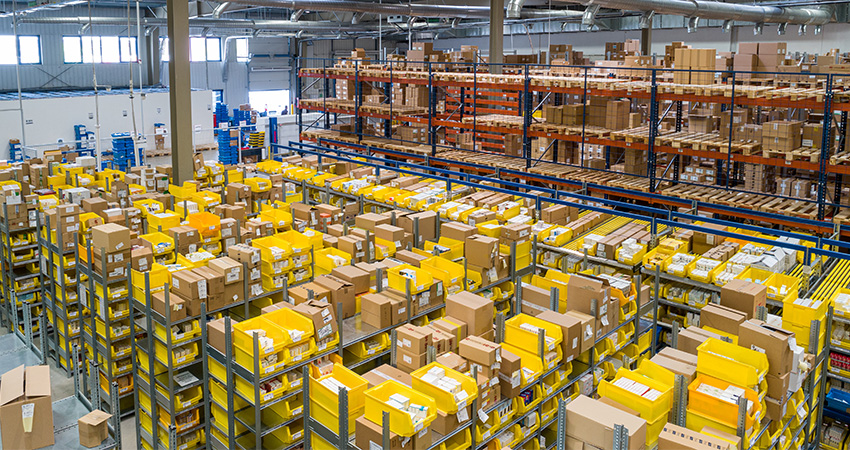Inventory is the largest balance sheet asset in most companies, and inventory management and optimization have a huge impact on company profitability and customer service. Inventory management, done properly, has an equally big impact on fulfillment space use, facility size and efficiency.
It behooves fulfillment directors to partner with merchants and purchasing to get the most benefit from inventory performance. Merchants may make the purchasing decisions and in doing so they have a tremendous impact on fulfillment efficiency and space utilization.
We will highlight 6 key inventory management metrics every ecommerce company should measure, how to calculate each one and areas where a partnership between fulfillment and merchandising will benefit company profitability and efficiency.
Inventory Turnover
Inventory turnover is the number of times a company sells and replaces its stock in a period of time. This can be measured at the total company, category or item level. Another way to understand turnover is to express it as the number of calendar days to free up cash from inventory. A company turnover of 3 times annually means it takes 122 days to get your money out of inventory (365 days/3 turns = 121.6 days).
Inventory turnover is equal to sales at cost for 12 months/average inventory at cost for 13 months (representing starting and ending inventory).
Weeks of Supply
This is a measure of inventory efficiency. Generally calculated at an item level, this indicates how many weeks of stock for a product you have in inventory. If the product is seasonal, you may want to increase supply because of the expected increased sales; or lower the on-hand because the season is complete.
Weeks on hand is equal to units on hand/unit sales for a specified time frame; this can be expressed in units or dollars.
Inventory Carrying Cost
Inventory carrying cost is the total of all expenses related to storage or holding unsold goods. The total includes the cost of capital, insurance and facility costs (e.g., equipment depreciation, lease, utilities, maintenance) as well as labor costs to maintain merchandise. Your inventory carrying costs can range between 20% to 30% of total inventory costs. It will make decisions regarding slow-moving and low gross margin product liquidation decisions more apparent.
Your inventory carrying cost is equal to facility costs plus labor costs plus cost of capital. Then allocate the total inventory carrying cost to each product on a cost per unit basis monthly.
Initial Customer Order Fill Rate
This is a great measure of customer service using order and fulfillment data. It measures the percentage of orders shipped complete in your order fulfillment standard. Many ecommerce companies are shipping a high percentage of orders the same day as receipt of order. To understand the initial order fill rate, if you have 1,000 orders today and you ship 700 orders complete (every line and quantity ordered by the customer), your initial order fill rate is 70%.
The backorder rate and initial customer order fill rate are not the same things. The backorder rate is generally 5 to 10 percentage points higher than the initial customer order fill rate.
Cost of Backorders
This is a study worth doing annually. Processing backorders is very expensive because of additional picking, packing, dunnage and shipping. To identify the customer service and fulfillment costs to service the back-ordered customer, include customer service costs; fulfillment costs for added labor to pick and ship backorders; additional supplies and shipping costs. Identifiable costs could be $15 to $20 per unit. However, the largest cost could be the potential loss of a customer’s lifetime value. Do you have a report showing total backorders for 12 trailing months? Most companies will need to develop one.
The cost of a back-ordered unit is equal to customer service costs plus fulfillment costs, divided by the number of back-ordered units fulfilled.
Return Rate
This is the percentage of gross unit demand returned. You should report returns by vendor, item, color and size. Fulfillment reasons for returns may include wrong product shipped and damaged in shipping.
The return rate is equal to the number of units returned divided by total units shipped. Return rates can be measured in units, orders or dollars.
Partnering with the Merchants
These are areas that we have seen fulfillment directors partner with merchants to improve inventory performance and warehouse efficiency.
Increase inventory turn: Changes in the on-hand quantity of product in storage greatly affects space utilization. It is often hard for merchants to dispose of overstocks. Reporting of weeks of supply, age of inventory and turnover will show where action needs to be considered. We have found that the most effective companies establish procedures and media that efficiently sell overstocks. The percentage of cost recovery will vary by media and timeframe. Learn how other companies deal with overstocks.
Impact of using inventory carrying costs: Turnover and age of inventory give you one perspective. Calculating and reporting inventory carrying costs will add another. Because inventory carrying cost is so high in most businesses, it doesn’t make sense to hold on to low margin or slow sellers very long. The margin earned is offset by the imputed cost. A monthly report makes candidates for liquidation more apparent.
Reduce backorder costs: Understand the components of your backorder costs and why the product was on backorder. Shipping and handling revenue often does not cover all costs. As mentioned earlier, the cost per back-ordered unit of merchandise can easily be $15 to $20 between customer service and fulfillment.
Reason for reports: If you don’t have a report, this is helpful to identifying fulfillment and transportation errors as well as other reasons such as color, fit, creative and content, etc. Reducing these errors will improve customer service and reduce fulfillment costs.
Summary
Internal company partnerships using inventory management metrics can help fulfillment become more efficient. Optimizing inventory is critical to profitability, labor costs and space utilization.
Brian Barry is President of F. Curtis Barry & Company

